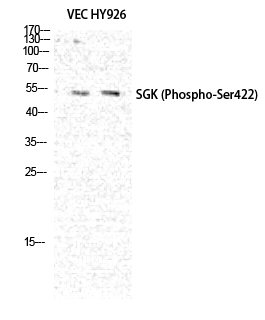Phospho SGK1 (S422) Cell-Based Colorimetric ELISA Kit
- 货号:KA1134C
- 应用:ELISA
- 种属:Human;Mouse;Rat
- 基因名称:
- SGK1
- Human Gene Id:
- 6446
- Human Swiss Prot No:
- O00141
- Mouse Swiss Prot No:
- Q9WVC6
- Rat Swiss Prot No:
- Q06226
- 储存:
- 2-8°C/6 months
- 其他名称:
- Serine/threonine-protein kinase Sgk1 (EC 2.7.11.1) (Serum/glucocorticoid-regulated kinase 1)
- 检测方法:
- Colorimetric
- 背景:
- catalytic activity:ATP + a protein = ADP + a phosphoprotein.,enzyme regulation:Two specific sites, one in the kinase domain (Thr-256) and the other in the C-terminal regulatory region (Ser-422), need to be phosphorylated for its full activation.,function:Protein kinase that plays an important role in cellular stress response. Activates certain potassium, sodium, and chloride channels, suggesting an involvement in the regulation of processes such as cell survival, neuronal excitability, and renal sodium excretion. Sustained high levels and activity may contribute to conditions such as hypertension and diabetic nephropathy. Mediates cell survival signals, phosphorylates and negatively regulates pro-apoptotic FOXO3A. Phosphorylates NEDD4L, which leads to its inactivation and to the subsequent activation of various channels and transporters such as ENaC, Kv1.3, or EAAT1.,induction:By serum and/or glucocorticoids. By excessive extracellular glucose and by TGF-beta, in cultured cells.,PTM:Regulated by phosphorylation. Phosphoinositide 3-kinase (PI3-kinase) pathway promotes phosphorylation at Ser-422 which in turn increases the phosphorylation of Thr-256 by PDPK1.,PTM:Ubiquitinated by NEDD4L; which promotes proteasomal degradation. Ubiquitinated by SYVN1 at the endoplasmic reticulum; which promotes rapid proteasomal degradation and maintains a high turnover rate in resting cells.,similarity:Belongs to the protein kinase superfamily. AGC Ser/Thr protein kinase family.,similarity:Contains 1 AGC-kinase C-terminal domain.,similarity:Contains 1 protein kinase domain.,subcellular location:Nuclear, upon phosphorylation.,subunit:Interacts with NEDD4 and NEDD4L.,tissue specificity:Expressed in most tissues with highest levels in the pancreas, followed by placenta, kidney and lung.,
- 功能:
- protein amino acid phosphorylation, phosphorus metabolic process, phosphate metabolic process, ion transport,cation transport, sodium ion transport, apoptosis, cell death, programmed cell death, monovalent inorganic cation transport, death, phosphorylation, metal ion transport,
- 细胞定位:
- Cytoplasm. Nucleus. Endoplasmic reticulum membrane. Cell membrane. Mitochondrion. The subcellular localization is controlled by the cell cycle, as well as by exposure to specific hormones and environmental stress stimuli. In proliferating cells, it shuttles between the nucleus and cytoplasm in synchrony with the cell cycle, and in serum/growth factor-stimulated cells it resides in the nucleus. In contrast, after exposure to environmental stress or treatment with glucocorticoids, it is detected in the cytoplasm and with certain stress conditions is associated with the mitochondria. In osmoregulation through the epithelial sodium channel, it can be localized to the cytoplasmic surface of the cell membrane. Nuclear, upon phosphorylation.; [Isoform 2]: Cell membrane.
- 组织表达:
- Expressed in most tissues with highest levels in the pancreas, followed by placenta, kidney and lung. Isoform 2 is strongly expressed in brain and pancreas, weaker in heart, placenta, lung, liver and skeletal muscle.
- June 19-2018
- WESTERN IMMUNOBLOTTING PROTOCOL
- June 19-2018
- IMMUNOHISTOCHEMISTRY-PARAFFIN PROTOCOL
- June 19-2018
- IMMUNOFLUORESCENCE PROTOCOL
- September 08-2020
- FLOW-CYTOMEYRT-PROTOCOL
- May 20-2022
- Cell-Based ELISA│解您多样本WB检测之困扰
- July 13-2018
- CELL-BASED-ELISA-PROTOCOL-FOR-ACETYL-PROTEIN
- July 13-2018
- CELL-BASED-ELISA-PROTOCOL-FOR-PHOSPHO-PROTEIN
- July 13-2018
- Antibody-FAQs


